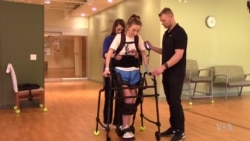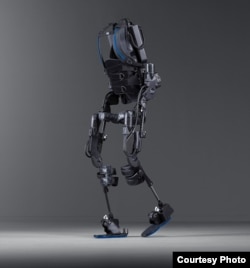An accident, a stroke, or a disease can leave someone paralyzed and unable to walk. That happens to more than 15 million people around the world each year.
But new technological advances and physical therapy could help some of them walk again.
Among the most promising is the use of robotic exoskeletons, like one made by Ekso Bionics. It looks a bit like a backpack that straps on the user’s back and around the midsection. Robotic ‘legs’ complete with foot panels extend from either side of the pack and wrap around the patient’s legs. A video game-style controller attaches to the pack with a long cord.
“I’m going to be a robot!”
Lindsey Stoefen has been doing physical therapy with the exoskeleton for an hour a day, as she works to recover from the rare disorder that put her in a wheelchair in October.
The 17-year-old athlete climbed into a specially designed exoskeleton for the first time in late April, after becoming an in-patient at Marianjoy Rehabilitation Hospital in Chicago.
She recalls being nervous. “I was like 'Dang, I’m going to be a robot!' I was scared at first. I was like, ‘Am I going to like it? Will I be okay?’ And once I got into it, I loved it.”
Lauren Bularzik, Lindsey’s physical therapist, says the exo robots help to accelerate the rehabilitation process. “For someone who takes a lot of energy to only walk a few feet, exo can get them up, can get them moving, it can supplement their movements, get that reciprocal pattern, encourage the correct motor planning.”
Beside speeding up recovery times, these robotic skeletons are especially helpful for those with paralysis, from spinal cord injuries and strokes. Using the machine can help some patients rewire their brains to use secondary muscles, so they can eventually walk again - without the device.
The downside
Scientists at the University of Notre Dame are leading the way with their work on wearable robots that allow patients to regain some or all of their mobility. But Patrick Wensing, assistant professor of mechanical engineering, says exoskeletons have one big drawback.
“While existing exoskeletons are very powerful, they don’t understand what the user wants to do. So in order to transition between activities in daily life, you often have to press a button interface to tell the exoskeleton ‘I would like to stand up now.’”
Wensing and his team are collaborating with Ekso Bionics, a leading developer of wearable robots, to create a machine that can understand what its user wants to do without implanted sensors and complicated control panels.
The new three-year project funded by The National Science Foundation’s robotic initiative, hopes to achieve a more fluid, intuitive system.
Taylor Gambon has spent the last year analyzing data from exoskeleton users and comparing them to models of everyday walking. “What we’re seeing is that slow walking in general, whether in the exoskeleton or just the human, is much different from walking at a speed that you would choose naturally.”
Later this year, the team will travel to Ekso Bionics' California headquarters, where they will work directly with exoskeletons to design programs that interact with users of various disabilities, so that more people like Lindsey Stoefen can get back on their feet again.










